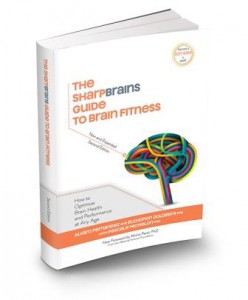Transcript: Q&A with Alvaro Fernandez about The SharpBrains Guide to Brain Fitness

Alvaro Fernandez
You can now read the full transcript of yesterday’s Q&A session on a variety of brain health and fitness topics, from memory improvement to heart rate monitors, exercise, meditation, “Grain Brain,” brain training, and more. A couple of good exchanges:
Question by Stephen Jepson
What specific physical activities contribute to the greatest changes in the brain in the shortest period of time? Once the neurogenesis and neuroplasticity that results from those changes has occurred what must one do to maintain that growth?
Take a look at chapter 3, fully devoted to exercise. In short, aerobic exercise is what brings highest returns, especially when you start from a low baseline (much higher marginal value in going from 0 to 3 hours per week than from 20 to 23). And great related question — mental exercise is key to influence where those new neurons go and how long they survive. So the media controversy about what is better, physical vs mental exercise, is essentially pointless. You need both, for complementary reasons.
______________________
Question by Jose Estrella and Ellen
Thank you for the very useful reviews and comments about brain training in chapter 8. It seems that, if I’d like to embark on an on line brain training program focusing on working and short term memory and higher level cognitive skills, I could start with Lumosity, brainHQ or Cogmed. How do I choose which one? How can I as a lay person know if a particular set of brain exercises is working for me? How do i gauge this. Thank you!
As we explain in the book we don’t endorse particular programs but there are a number of brain training options that make may sense based on your own priorities and context. We share a lot of the research we did on the science behind the main programs and their customer satisfaction rates so you can see which one to start with…it is not a purely scientific decision but more of a practical one. What is your budget? Do you need a lot of supervision or are self-directed? Do you prefer a “younger” interface, like Lumosity’s, or one designed for 50+ users, like Posit Science’s brainHQ? Once you start, what is critical is your other question — how to objectively evaluate progress. We suggest several options in chapter 9, from keeping subjective impressions to things like BrainBaseline app. I believe this self-assessment part is a key
 component of the brain fitness puzzle and good news is there’s significant progress under way.
component of the brain fitness puzzle and good news is there’s significant progress under way.To Learn More:


